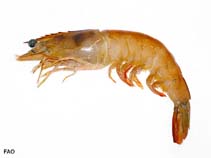Penaeus subtilis (Pérez Farfante, 1967)
Southern brown shrimp
Classification / Names Κοινά ονόματα | Συνώνυμα | CoL | ITIS | WoRMS
Malacostraca | Decapoda | Penaeidae
Environment: milieu / climate zone / εύρος βάθους / distribution range Οικολογία
; Υφάλμυρο; εύρος βάθους 1 - 190 m (Αναφ. 8). Tropical; 23°N - 24°S, 86°W - 34°W
Distribution Χώρες | Περιοχές FAO | Οικοσυστήματα | Παρουσίες | Εισαγωγές
Western Atlantic: from the Antilles and Honduras to Brazil.
Length at first maturity / Μέγεθος / Weight / Age
Γεννητική Ωρίμανση: Lm 5.8, range 13 - ? cm Max length : 16.5 cm TL αρσενικό/απροσδιόριστο; (Αναφ. 8); 20.5 cm TL (female)
Life cycle and mating behavior Γεννητική Ωρίμανση | Αναπαραγωγή | Γεννοβολία | Eggs | Γονιμότητα | Larvae
Main reference
Αναφορές | Συντονιστής | Συνεργάτες
Holthuis, L.B. 1980 FAO Species Catalogue. Vol. 1. Shrimps and prawns of the world. An annotated catalogue of species of interest to fisheries. FAO Fish. Synop. 125(1):271 p. Rome: FAO. (Αναφ. 8)
IUCN Red List Status
(Αναφ. 130435: Version 2025-1)
CITES status (Αναφ. 108899)
CMS (Αναφ. 116361)
Threat to humans
Human uses
αλιεία: Εμπορικό(ά)
FAO - αλιεία: landings, species profile | FIRMS (Stock assessments) | FishSource | Η θάλασσα γύρω μας
Εργαλεία
Περισσότερες πληροφορίες
Σύσταση δίαιτας
Κατανάλωση τροφής
Θηρευτές
Διαδικτυακές πηγές
BHL | BOLD Systems | CISTI | DiscoverLife | FAO(αλιεία: species profile; publication : search) | Fishipedia | GenBank (genome, nucleotide) | GloBI | Gomexsi | Google Books | Google Scholar | Google | PubMed | Δέντρο Ζωής | Wikipedia (Go, αναζήτηση) | Zoological Record



